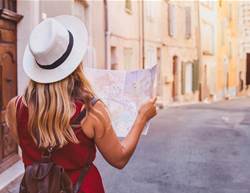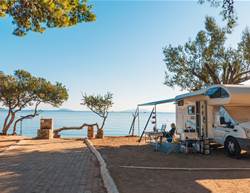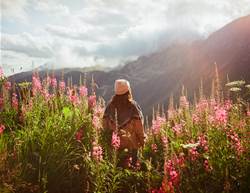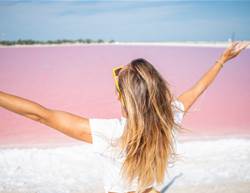“More and more people have discovered a love of wild swimming over the last few years, with increasing numbers eschewing their local indoor pool in favour of natural bathing spots,” says writer Amanda Canning.
“The benefits are well documented, particularly of cold-water swimming. Scientific studies report benefits to physical and mental health ranging from boosted immunity and a lower risk of heart disease to reduced negative moods and increased wellbeing. And, of course, the science only tells one part of the story.”
“To understand what draws so many people to wild swimming, we must look to something a little less easy to measure and quantify; we must look to the title of this series – joy. The joy of wet mud between your toes as you cast off from a river bank. The joy of leaping off concrete and into cool water on a hot day in the city. The joy of drifting on your back and letting the sounds of surrounding nature calm your mind. The joy of that warm flask of tea or cold can of beer once you’re wrapped in a towel and are sat gazing back at the water.”
Here are five wild swimming spots around Australia, from the remote Kimberley to just an hour out of suburban Sydney.
1. Get wild on the remote Gibb River Road
Dalmanyi, the Kimberley, Western Australia
If you’re ready to head off the beaten track in pursuit of true watery wilderness, this journey is for you. The Gibb River Road is one of Australia’s greatest 4WD adventures. It stretches from Derby in the west to Kununurra in the east (two pretty remote towns themselves), passing through the continent’s wild northwest corner. This is far Outback, sparsely populated country – and it gets sticky hot. Fortunately, strung out along the 660km road is a series of spectacular swimming spots.
Ancient river culture
One of the best is Dalmanyi (Bell Gorge, pictured above). It’s on the land of the Ngarinyin people in Wunaamin Conservation Park. Aboriginal people have conserved and cared for this country for at least 60,000 years, and today First Nations communities make up about half the population of the Kimberley.
Rivers and swimming holes like Dalmanyi are important places for family gatherings, fishing and food collecting, as well as locations for ceremony and law. Often rock art is located close to rivers, and many are home to ancestral and spirit beings.
Choose your pool
Your own encounter with Dalmanyi starts after the walk from the car park along a rock-filled dry creek bed. You come upon the river suddenly. The terrain opens out to rusty rock outcrops under a big blue sky, cut through by the cool waters of Bell Creek. The river, its banks made of flat, smooth and often slippery stone, spreads out into shallow pools before cascading 150m into a plunge pool shaded by the steep walls of the gorge.
The view from the top following the river along its rugged path is spectacular – but at this point you’ll be more interested in jumping in than admiring it.
To reach the plunge pool, where the waterfall has gouged a wide, deep hole where you can totally immerse yourself, you must first wade across the river and scramble down a very steep descent. Here you’ll be surrounded by the cliffs of the gorge – stacked layers of red rock that enclose the pool on all sides and make you feel like you’ve shrunk to the size of a pebble. For a strong workout, swim up to the waterfall. From there, you can continue downstream, swimming through deep water and scrambling over boulders, to lower pools where there’s likely to be fewer humans and more wildlife. Just remember you’ll have to swim back against the current.
If that doesn’t sound like your idea of fun, head upriver instead and find yourself a likely soak hole among the pleasant rocky pools. Or just find a spot on one of the rocky platforms to recline in the shade or bask in the sun.
My swim: Monique Choy
“My first glimpse of the gorge took my breath away, but it’s the wildlife that sticks in my mind. We scrambled down to the falls, and followed the current downriver to the lower pools. Here in the quiet we spotted wallabies, expertly bounding up the steep terrain, and goannas and geckos sunning themselves on the rocks. Back at the top, we looked into the plunge pool to see a yellow snake swimming in a splash of sun. It held its position in the fierce current – all muscle and wild beauty.”
Getting there
The Dalmanyi trailhead is 40km off the 4WD-only Gibb River Road in Western Australia, from where it’s a 2km return walk. You can hire 4WD campers in Broome; a good three-day loop from Broome takes in Dalmanyi, Windjana Gorge and Tunnel Creek (250km west).
Challenge level
The rocks around the falls are super-slippery, so watch your step and don’t rush. This is remote country with very limited services so you should be prepared. Carry plenty of water, use sun protection and wear shoes with good grip. There is no mobile phone reception.
Further information
Dalmanyi is open May to October (during the dry season). Park entry fees for Wunaamin Conservation Park apply, and no dogs are allowed. There’s a pit toilet in the car park.

2. Wade at a wildlife-rich, Indigenous-owned park
Green Patch Beach Booderee National Park, NSW
There aren’t too many spots where you can swim in the presence of wildlife that you won’t encounter anywhere else in the world. At Green Patch Beach, tucked within Aboriginal-owned Booderee National Park, you can do just that. Before you even wet your feet, you may come face-to-face with kangaroos, wallabies, parrots and rosellas, which roam free in the bushland.
Rare flora and fauna
A vast range of habitats, from southern mahogany forests to seagrass meadows, is responsible for Booderee’s biodiversity. It’s home to more than 460 different native plants, 200+ bird species and at least 30 native mammals.
Avian aficionados should keep their eyes peeled for the hard-to-spot eastern bristlebird, threatened nationwide but thriving here thanks to efforts to reintroduce some of the country’s most at-risk endemic species. One of the rarest is the long-nosed potoroo. While it’s doubtful you’ll spot this shy nocturnal relative of the kangaroo, you can improve your chances of seeing animals active only at night – pitch up at Green Patch’s campsite and you can sleep for real among these curious creatures.
Swim in crystalline seas
The walk to the beach, through a forest of blackbutt trees, has been filled with the beautiful cacophony of foraging crimson rosellas, rainbow lorikeets and Australian king parrots – but as you cross the eucalypt-shaded wooden bridge to the crescent-shaped beach, it fades. All you’ll hear is the sea gently lapping onto shore, and the sound of frolicking kids. The smell of the salty breeze and sizzling barbecues vie for olfactory attention.
From here, take in all of Jervis Bay, the cliffs of Point Perpendicular and Bowen Island. Like a comforting embrace, the bay protects the beach from the ocean swell. Sink your your feet into the blindingly white, soft sand and immerse yourself in the sun-warmed aquamarine waters. The East Australian Current, carrying warm water from the Coral Sea, mixes with cooler water from Bass Strait, delivering sparkling clarity. Swimming here is a deeply restorative experience. It feels like you’ve stumbled into one of Australia’s last great wildernesses; it’s incredible to think it’s within such easy reach of urbanity.
First nations know-how
What really makes Green Patch special is the fact that Booderee lies in the hands of its traditional owners. The park was conferred onto the Wreck Bay Aboriginal Community Council in 1995, who co-manage it with Parks Australia. The Yuin People, who have resided here for millennia, named it Booderee – ‘bay of plenty’ in the Dhurga language.
Today, Elders continue to pass on knowledge in nature’s classroom, maintaining their spiritual bond with the land and water. As you bathe in these glorious waters, take a moment to pay your respects to the First Australians, the saltwater people of past, current and future generations.
My swim: Helen Iatrou
“Visiting Australia after a long absence, Green Patch reminded me of the country’s immeasurable environmental wealth. Sitting in the clearing, it was surreal to witness eastern grey kangaroos oblivious to my presence, shrieking rainbow lorikeets flitting around my shoulders, and a kookaburra glaring inquisitively at schoolchildren. I re-baptised myself in the ocean, sharing the waters with a pod of bottlenose dolphins. A final surprise awaited on my departure: an echidna, burrowing among leaves.”
Getting there
Green Patch is around three hours’ drive south of Sydney. Shuttle services operate between Sydney and Jervis Bay, from where taxis are available. Trains run between Sydney and Bomaderry. From there, buses depart for Huskisson and Vincentia, an easy cab ride away.
Challenge level
Shallow, calm waters make Green Patch family-friendly, though keep a close eye on the kids as there are no lifeguards on duty. Swimmers should always head out with a companion. One good reason is the presence of sharks; while there have been no reported attacks, avoid entering the water between dusk and dawn, when sharks and rays are hunting.
Further information
A minimum 48-hour park pass, which can be purchased online or at the entry station, is required to enter Booderee. Pack a picnic and plenty of water. BBQs are available. Book the well-equipped beachside campsite early if you plan to visit between November and April.

3. Take a bush swim on the fringes of Sydney
Jellybean Pool, Blue Mountains, NSW
A favourite place to dunk the kids over the long, hot summer holidays, Jellybean Pool is in the Greater Blue Mountains World Heritage Area, just an hour’s drive from the centre of Sydney.
The water here can be brisk at any time of year, so it’s a good idea to work up a sweat before you swim by taking the nearby 8km loop walk to Red Hands Cave. The area is the traditional land of the Darug and Gundungurra peoples, and the track leads to one of the best Aboriginal stencil galleries in the Sydney region.
Suitably warmed up, head to Jellybean. You access the pool via a short, steep bush track from the car park. It’s easy to tote in lilos and picnic goodies – but once you reach the pool, it feels like you’re deep in the wilderness. The swimming hole is surrounded by gum-tree-clad sandstone cliffs – it’s almost like you’ve stumbled into a secret chamber in the bush. And though it’s on a freshwater river, the sandy bank gives the place a beachy feel; in fact, in 2022 it was listed among the country’s top 20 beaches by Tourism Australia.
There’s plenty of sand and plenty of shade, but there can be plenty of people too, if you catch it on a busy day. Avoid high-summer weekends and school holidays, unless you’re looking to meet some local playmates. Come on a weekday or anytime in winter, and you’ll likely have the place to yourself. And if Jellybean is too crowded, try nearby Blue Pool or Glenbrook Gorge, which are less popular but not as easy to access for kids.
Stunning sandstone
Some of the unique features of the environment around Sydney are the sandstone boulders, ridges and escarpments that form the bones of the bush. They’re scattered among the trees and carved into sculptural shapes by wind and rain. At Jellybean Pool, sandstone cliffs enclose the pool in a natural amphitheatre. There’s nothing better than floating (ideally on a lilo) in the clear water and looking up at a patch of blue sky encircled by grey-green vegetation.
Follow the tranquil river upstream to discover more rock-fringed swimming spots. You’ll easily find a sandstone boulder with your name on it for a little sunbaking. The water is tinted a natural tea-brown in the shallows, shading into darker tones as you get into the deeper sections. Look out for grass-trees among the twisted trunks of the gums – their sprays of needles are a bright youthful green, though they may be 300 years old. Here and there, cockatoos and magpies sweep through the trees and, if you’re lucky, you may see a blue kingfisher zipping across the water.
My swim: Monique Choy
"I arrived at Jellybean on a weekday morning in late spring – one of the luxuries of working freelance – having stopped at Kickaboom for a takeaway coffee and vegan toastie served with lotus-root chips.
"Two little kids were pottering in the sand with their grandad so I headed around to the left, drawn by the soothing sounds of a waterfall behind the screen of trees, and stepped into the bracingly cold, invigorating water. The bright sky and sun-lit treetops were beautifully mirrored in the water’s calm surface. I floated for a while, and when a few people turned up with towels slung over their shoulders, I decided it was time to head back to work. An hour later I was at my desk in the city – but my damp hair still held the scent of the bush."
Getting there
Access the pool via the car park in Glenbrook, next to Blue Mountains National Park, 60km west of Sydney. The track is fairly steep, but only 500m long. On busy days there’s an overflow carpark, or you can catch the train to Glenbrook and walk (about 2km).
Challenge level
The pool is a popular choice for children, but it’s very deep in places and the current can be strong – supervise kids at all times. Many people jump from the cliffs surrounding the pool. This is not recommended – there are submerged rocks and, unfortunately, there have been fatalities here.
Further information
National park fees apply for vehicles, or you can park in the parking lot just outside the gate, which is open daily October to March. There are no toilets or facilities at the pool.

4. Float centre-stage in a granite amphitheatre
Lake Williams, Western Australia
Lake Williams absorbs all the attention you give it. On the first sight, its stillness is contagious, inviting a slow, contemplative walk to the shoreline. As the shady access track gives way to an open expanse of lake, with eucalyptus residue lingering in the humidity, the air smells and even tastes different somehow.
Stillness doesn’t mean silence, though: listen attentively and you’ll hear faint sounds of ripples from waterbirds on the lake’s surface; the calling of raptors overhead, and songbirds in the bush; the breeze coming and going across land and water and rock.
The feel of smooth granite and the soft silty shoreline is a blessing to bare feet, and has been for generations – the traditional Aboriginal Australian owners of the area are the Minang people and pieces of their ancient stone tools have been found at nearby Lights Beach. It’s easy to imagine this place being used as the perfect spot to camp, hunt and gather long before colonisation – it wasn’t until the 1830s that William Bay and the lake were named after the British Arctic explorer William Edward Parry.
Swimming in silk
Those first tentative footsteps into the lake are bracing. Its water – chill in winter, cool even in summer is filtered through the soil of paddocks and the roots of karri, marri, sheoak and peppermint trees. Depending on seasonal rainfall, it flows or trickles or seeps into the lake like caramel-coloured silk. Softened by the vegetable tannins it gathers on the way, it feels great on the skin.
There’s zero visibility in the water, which makes it mysterious, slightly disconcerting. Feeling your way through the shallows, towards the centre, is a tactile experience.
You’ll feel the squishy silt underfoot, unless you wear rubber sandals, and there’s an occasional underwater branch or boulder to navigate.
As the water deepens and you become weightless, it’s as if the lake is bottomless. If vertigo sets in, roll over and float, outstretched, eyes wide open, taking in the natural palette of blue sky, green bush and rust-coloured granite.
On the lookout
Back on dry land, lolling on that granite, look up, down and around. In pools and puddles, especially in spring, frogs and tadpoles are everywhere. Two unmistakeable animals to listen out for are the aptly named motorbike frogs and their onomatopoeic cousin, the pobblebonk. A scratchy sound of reptilian claws reveals the presence of King’s skinks – lizards that can grow as long as a person’s forearm – emerging to sunbathe on the rock.
The translucent wings of dragonflies dip down on the water. Square, grassy pellets of poo in gullies on the rock, and along the tree line, indicate that western grey kangaroos come here to drink at dawn and dusk. It’s rare to be absolutely alone in the bush.
My swim: Virginia Jealous
“It’s June, a beautiful mid-week day at the start of the Australian winter: hot in the sun but cool in the shade, and there’s a chill wind. Swimming is not on the agenda as I walk to Lake Williams with a flask of tea and a sandwich in my backpack. I pass no-one on the track in.
“There’s a sheltered dip in the granite outcrop where I sit and look for a while. The water’s like glass, the breeze drops, and without hesitation I whip off my clothes and run like a kid towards the water. I plunge in and emerge breathless and glowing. It’s a baptism of sorts: refreshing, restorative, invigorating. Lying on the warm rock, waiting for the sun to dry me, I can’t imagine anywhere I’d rather be.”
Getting there
There is no public transport to Lake William (not to be confused with Lake William at nearby West Cape Howe). Drive to Lights Beach, 13km from the town of Denmark. From the car park, walk or cycle the 1.5km track to Lake Williams. Hikers on the Bibbulmun Track will also pass by the lake.
Challenge level
Getting to Lake Williams requires a walk over 200m of smooth rock from the access track. The lake is naturally enclosed, with flat, easy entry to the water and – though there might be surface wind-chop – there’s no current or tide. The average temperature of the lake is around 16 degrees Celsius.
Further information
Entry to Lake Williams is free and it’s open year-round. There are no facilities on site. The nearest toilet and changing rooms are at Lights Beach, and the nearest cafes and shops are in Denmark.

5. 4WD to a hidden swimming hole
Booloumba Creek, Queensland
For the uninitiated, there’s a reason why Australia has a reputation as a ‘sunburnt country’. It’s true that along the East Coast, wide swaths of sandy beach and warm ocean waves are never far away – if freshwater is more your flavour, you’ll have to work a little harder to find it.
Compared to other nations, inland waterways are few and far between, and many are brackish and tannin-stained, hiding creatures that may lurk below. Worst of all, they may be ephemeral – a lake might exist on a map, but not necessarily on the ground.
Understanding this provides context for why the Sunshine Coast’s Booloumba Creek is spoken about with such hushed reverence. It’s not the warmest swimming hole nor the biggest, and it’s definitely not the easiest to access. What it is, however, is one of the clearest swimming spots you’ll find in southeast Queensland.
An aquamarine oasis
Booloumba Creek’s turquoise waters have a crystalline quality that allows you to see straight to the bottom. Its shores are lined with rainbow-hued pebbles, which kids and adults alike will love to collect – when they’re not using the rope swing to fall into the cool waters, or exploring the creek further upstream.
But part of the appeal of an afternoon at Booloumba Creek is that while it’s not particularly remote – Noosa is just an hour’s drive away – it still has all the makings of a true Aussie Outback adventure.
You’ll first encounter it as you enter Conondale National Park, just outside of the cute country town of Kenilworth. But you’re not at the swimming spot – not yet. You’ll need to cross over the creek several times on the way to your destination. This can only be done in a clearance 4WD or, if the water’s not flowing too high or fast, on foot. Only then will you arrive at the day-use area, and find the swimming hole hidden beyond in the native bush.
Endless adventures
Once you’re in the water, you could easily spend a day drifting idly across its surface, gazing at the trees high above. But the best part about Booloumba Creek is that the swimming doesn’t end at the day-use area, which can get crowded on hot summer days. Keen bushwalkers can spend four days navigating their way around the park’s 56km track one of Queensland’s Great Walks, stopping to cool off in the water along the way.
If you’ve only got a day to spare, you can also hike the 3km Booloumba Falls Walk, which will take you along the scenic creek to even more secluded rock pools, waterfalls and cascades. Throw in shady shores and its off-grid nature, and you’ve got yourself the textbook definition of swimming oasis.
My swim: Jessica Wynne Lockhart
“As a Canadian, I’ll be the first to admit that I’m a freshwater swimming snob. For most of my life, I’ve been spoiled with unlimited access to pristine lakes, filled with some of the clearest water in the world. So, when I moved to Australia, I had to put my fish phobia aside and get used to diving into waters where I wasn’t entirely sure what lay below.
“Discovering Booloumba Creek was a true revelation. Only 30 minutes from where I live, its sapphire waters are so clear that you can count every stone at the bottom – meaning there’s absolutely nowhere for yabbies (freshwater crayfish) or eels to hide.”
Getting there
Booloumba Creek is in Conondale National Park, an hour’s drive inland from Noosa and 13km from Kenilworth. To get to the main day-use area, you’ll need a high-clearance 4WD to make several creek crossings. If you’re fit and water levels are low, you can park at the entrance and wade through the creek on foot.
Challenge level
With relatively shallow and warm waters, this is an all-ages outing, but paths to the swimming hole are undeveloped and not suited to those with mobility issues. Although Booloumba is not far from civilisation, it’s in an area with limited phone reception. It always pays to be aware of snakes.
Further information
Conondale National Park is a wilderness area with few facilities; stock up in nearby Kenilworth. Picnic tables, barbecues and toilets can be found at the day-use area. Rubbish bins are not provided; take out what you take in.

This is an edited extract of Lonely Planet’s Joy Of Wild Swimming. Reproduced with permission from Lonely Planet © 2022.



.jpg&h=90&w=90&c=1&s=1)






